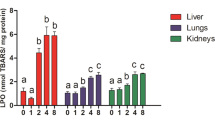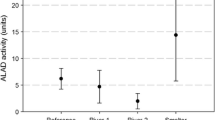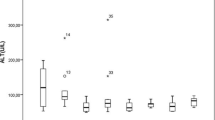Abstract
Quantitative studies were conducted on tissue and organs for beach mice, Peromyscus polionotus, exposed to the toxin 2,3,7,8- tetrachlorodibenzo-p-dioxin (TCDD) in field and laboratory environments. Hepatic tissue from 52 animals was examined using an ultrastructural stereological technique to determine differences in smooth endoplasmic reticulum (SER), rough endoplasmic reticulum (RER) and mitochondria. Organs were examined for differences in weights. Histopathological examinations were also performed on various tissues. To support the studies, chemical analysis of the soil, liver and pelt samples for TCDD content as well as the determination of the TCDD concentration in the alumina gel used in the dusting study was conducted. Fifteen animals were collected from a unique military test site in Northwest Florida where they had been continuously exposed to soil levels of 10 to 710 parts-per-trillion (ppt) TCDD. Twelve other animals from a field control site were exposed 10 times in 28 days to 2.5 parts-per-billion (ppb) TCDD applied as an alumina gel dust to their pellage. All remaining animals were from the same field control site and were not exposed to TCDD in the field or in the laboratory and therefore served as controls. The levels of TCDD in composite liver samples from mice collected in the field varied from 960 ppt for females to 1300 ppt for males, while a composite liver level of TCDD for the laboratory animals was 125 ppt. No significant histopathological lesions were observed. When field animals were compared with laboratory animals, significant differences were noted in certain organ weights and cellular structural components. Some of these differences could possibly be attributed to dissimilarities in field and laboratory environments.
Access this chapter
Tax calculation will be finalised at checkout
Purchases are for personal use only
Preview
Unable to display preview. Download preview PDF.
Similar content being viewed by others
References
Cockerham, L. G., 1979, Ultrastructural study of selected tissues mice exposed to 2,3,7,8–tetrachlorodibenzo-p-dioxin (TCDD), Doctoral Dissertation, Colorado State University, Fort Collins, Colorado, December.
Cockerham, L. G., Young, A. L., and Thalken, C. E., 1980, Histo- pathological and ultrastructural studies of liver tissue from TCDD-exposed beach mice (Peromyscus polionotus). FJSRL-TR-80- 0008, Frank J. Seiler Research Laboratory, USAF Academy, Colorado, March.
Cockerham, L. G., and Young, A. L., 1982, The absence of hepatic cellular anomalies in TCDD-exposed beach mice — a field study. (Submitted for publication).
Doull, J., 1980, Factors influencing toxicology, in: “Casarett and Doull’s Toxicology, The Basic Science of Poisons,” Doull, J., Klassen, C. D., and Amdur, M. O., eds., 2nd ed. New York: Macmillan Publishing Co., Inc., 70–83.
Fries, G. F., and Marros, G. S., 1975, Retention and excretion of 2,3,7,8-tetrachlorodibenzo-p-dioxin by rats, J. Agr. Food Chem., 23(2):265–267.
Greig, J. B., and DeMatteis, F., 1973, Effects of 2,3,7,8-tetra- chlorodibenzo-p-dioxin on drug metabolism and hepatic microsomes of rats and mice, Environ. Health Perspect., 5:211–219.
Gupta, B. N., Vos, J. G., Moore, J. A., Zinki, J. G., and Bullock, G. C., 1973, Pathologic effects of 2,3,7,8-tetrachlorodibenzo- p-dioxin in laboratory animals, Environ. Health Perspect., 5:125–140.
Hutterer, F., Klion, F. M., Wengraf, A., Schaffner, F., and Popper, H., 1969, Hepatocellular adaptation and injury: structural and biochemical changes following dieldrin and methyl butter yellow, Lab.Invest., 20: 455–464.
Kociba, R. J., Keyes, D. G., Beyer, J. E., Carreon, R. M., Wade, C. E., Dittenber, D. A., Kalnins, R. P., Frauson, L. E., Park, C. N., Barnard,S. D., Hummel, R. A., and Humiston, C. G., 1978, Results of a two year chronic toxicity and oncogenicity study of 2,3,7,8-tetrachlorodibenzo-p-dioxin in rats, Toxicol. App. Pharmacol., 46:279–303.
Leng, M. L., 1979, Comparative toxicology of various chlorinated dioxins as related to chemical structure. Paper presented at symposium of Collabortive International Pesticide Advisory Council (GIPAC), Baltimore, Maryland, June 7.
Meek, G. A., 1976, Stereology, in: “Practical Electron Microscopy for Biologists,” 2nd ed. New York: John Wiley and Sons, 409–410.
Pate, B. D., Voight, R. C., Lehn, P. J., and Hunter, J. H., 1972, Animal Survey of Test Area C-52A, Eglin AFB Reservation, Florida, AFATL–TR-72–72, Air Force Armament Laboratory, Eglin AFB, Florida, April.
Schwetz, B. A., Norris, J. M., Sparschu, G. L., Rowe, V. K., Gehring, P. J., Emerson, J. L., and Gerbig, C. G., 1973, Toxicology of chlorinated dibenzo-p-dioxins. Environ. Health Perspect., 5:87–99.
Shirley, E., 1977, The Analysis of orgen weight data, Toxicology, 8: 13–22.
Stenger, R. J., 1970, Organelle pathology of the liver: the endo-plasmic reticulum, Gastroenterology, 58: 554–574.
Van Logten, M. J., Guypta, B. N., McConnell, E. E., and Moore, J. A., 1981, The influence of malnutrition on the toxicity of 2,3,7,8-tetrachlorodibenzo-p-dioxin (TCDD) in rats, Toxicology, 2l (l): 77–88.
Vos, J. G., Moore, J. A., and Zinkl, J. G., 1974, Toxicity of 2,3,7,8-tetrachlorodibenzo-p-dioxin (TCDD) in C57B1/6 mice, Toxicol Appl. Pharmacol., 29(l):229–241.
Young, A. L., 1974, Ecological studies on a herbicide equipment test area (TA C52-A), Eglin AFB Reservation Florida. AFATL- TR-74-12, Air Force Armament Laboratory, Eglin AFB, Florida, January.
Young, A. L., Thalken, C. E., Ward, W. E., 1975, Studies of the ecological impact of herbicides on the ecosystem of test area C-52A, Eglin AFB, Florida. AFATL-TR-75–142, Air Force Armament Laboratory Eglin AFB, Florida, October.
Young, A. L., Calcagni, J. A., Thalken, C. E., and Tremblay, J. W., 1978, The toxicology, environmental fate and human risk of Herbicide Orange and its associated dioxin, OEHL-TR-78–92, USAF Occupational and Environmental Health Laboratory, Brooks AFB, Texas, October.
Young, A. L., Thalken, C. E., and Harrison, D. D., 1979, Persistence, bioaccumulation and toxicology to TCDD in an eco-system treated with massive quantities of 2,4,5-T herbicide. Paper presented at the 178th American Chemical Society National Meeting, Washington, D.C., September 13–14.
Author information
Authors and Affiliations
Editor information
Editors and Affiliations
Rights and permissions
Copyright information
© 1983 Plenum Press, New York
About this chapter
Cite this chapter
Cockerham, L.G., Young, A.L. (1983). Ultrastructural Comparison of Liver Tissues from Field and Laboratory TCDD-Exposed Beach Mice. In: Tucker, R.E., Young, A.L., Gray, A.P. (eds) Human and Environmental Risks of Chlorinated Dioxins and Related Compounds. Environmental Science Research, vol 26. Springer, Boston, MA. https://doi.org/10.1007/978-1-4613-3599-3_25
Download citation
DOI: https://doi.org/10.1007/978-1-4613-3599-3_25
Publisher Name: Springer, Boston, MA
Print ISBN: 978-1-4613-3601-3
Online ISBN: 978-1-4613-3599-3
eBook Packages: Springer Book Archive




